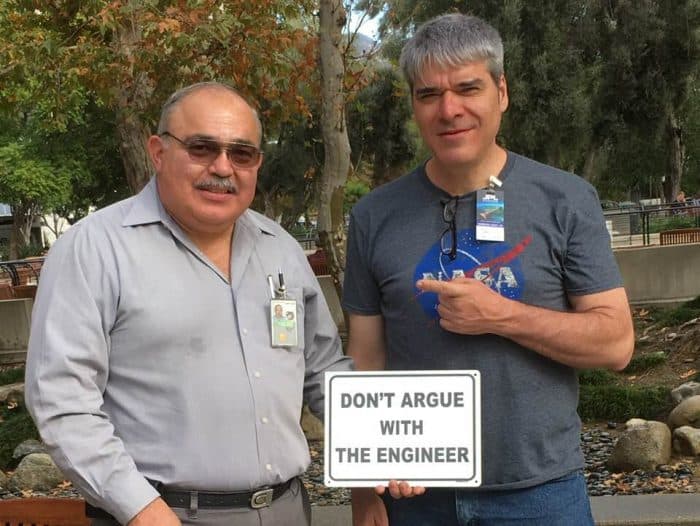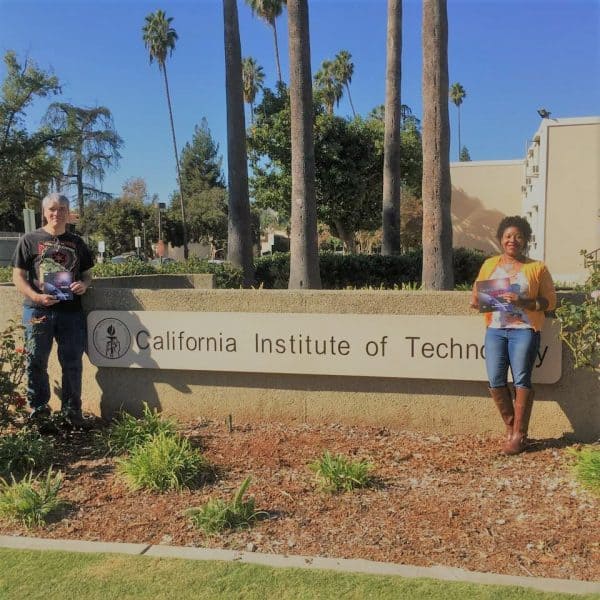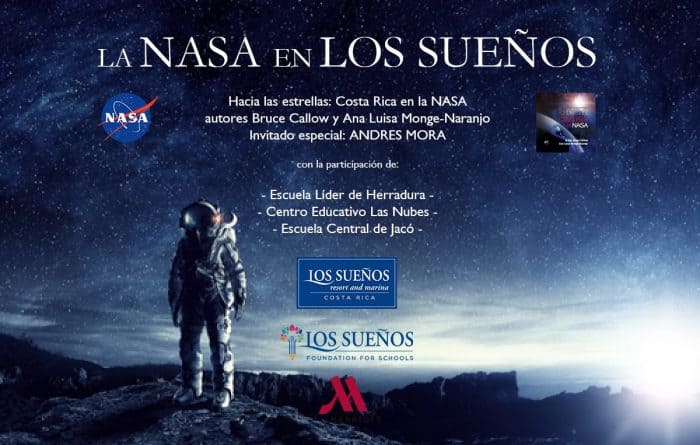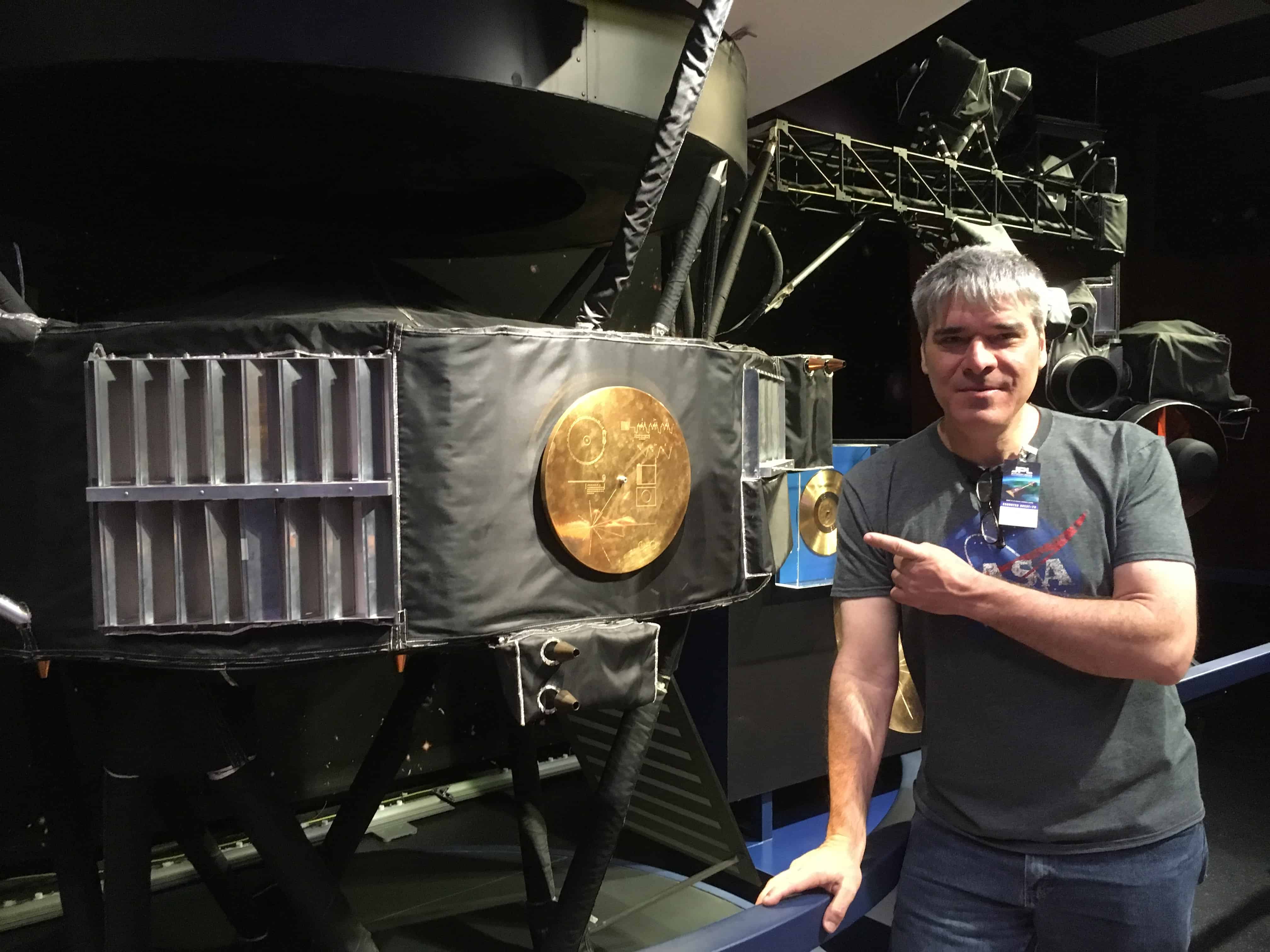Last September, the book “To the Stars: Costa Rica in NASA” was launched by the Costa Rican Institute of Technology’s publishing house. This bilingual book, which I co-authored, introduces readers to the Costa Ricans who were hired by NASA or work(ed) at NASA centers as contractors.
Their stories are related in an easy-to-read interview format and provide concrete advice from 10 exceptional Costa Ricans who achieved their NASA dreams as engineers, scientists and technicians.
I recently returned from Pasadena, where I visited NASA’s Jet Propulsion Laboratory (JPL, the workplace of four Ticos) and the California Institute of Technology.
What I’ve been up to since the book launched last September:
Co-author Ana Luisa Monge-Naranjo and I have embarked upon a series of book workshops with Costa Rican elementary and high school students. Our next workshops are at the University of Costa Rica planetarium, United World College and the Marriot Hotel, Los Sueños. One of our main priorities is to work with rural populations so we are grateful to the Los Sueños Foundation for organizing a workshop for students from Costa Rica’s Pacific coast.
Two personalities from our book, Andres Mora and Jeannette Benavides, will be videoconferencing directly with the students at that event. It is a lot of fun making students aware of their Costa Rican NASA heroes as most only know of Franklin Chang. One of the most frequent comments we hear from students is, “I didn’t know there were so many [Ticos in NASA].” It’s a great feeling to be part of this awakening.
About my recent invitation to JPL:
I was invited by Andrea Angrum, who has worked at JPL for 33 years and has vast experience with public outreach and education programs — including the Voyager mission. JPL is highly secure facility; visiting it requires vetting before entry is granted, and an authorized guide has to accompany visitors at all times. I am very grateful to Andrea and Fernando Peralta for dedicating so much of their time to my visit. At JPL, I met two of the Costa Ricans profiled in our book (Victor Mora and Alfredo Valverde) as well as people from the Dawn and Voyager missions.

Over the past 3 years, the Voyager and Dawn outreach teams, as well as Sandra Cauffman and Jeannette Benavides, have actively supported my outreach work with Costa Rican students. This has produced some thought provoking interactions and created personal connections between students and people at NASA.
Read more in The Tico Times:
- NASA pioneer answers student questions
- NASA’s Dawn mission inspires Costa Rican students
- Costa Rican students get surprise trip of a lifetime
- NASA dreams come true for Costa Rican teens
Visiting JPL allowed me to complete a circuit that I inadvertently began three years ago, when I started writing about Costa Ricans in NASA for The Tico Times. I saw where spaceships and Mars rovers are built by people like Alejandro and Joseph Mora of San Antonio de Desamparados. It was extraordinary to see the spacecraft assembly facility where the Cassini spacecraft was constructed and have Victor Mora (also of San Antonio de Desamparados) explain the process to me.
I observed technicians building the Mars 2020 rover, which will take the search for past and present life on Mars to the next level. Blue Valley School graduate Alfredo Valverde gave me a briefing about JPL’s Deep Space Network Mission Control Center that supports NASA’s interplanetary spacecraft missions. Data from all over the solar system streams into telescopes in California, Australia and Spain and it’s all managed from that room. No surprise that it is also known as the “Center of the Universe.”
I look forward to sharing these kinds of experiences with Costa Rican students in our upcoming workshops.
What I learned from my visit to JPL:
I was in awe, imagining what has been accomplished in that room and what will be coming in the next 20 years and beyond. On November 26, the InSight lander will touch down on Mars. I am very excited about the Europa Clipper mission, which will search for life on that icy moon of Jupiter. Alfredo Valverde made important contributions to the development of that mission.
My favorite JPL mission over the past three years has been Dawn, which explored two worlds in the asteroid belt, Vesta and Ceres. On Oct. 31, Dawn officially completed its mind-boggling 11-year mission. I paid my personal respects to its vast accomplishments when I met Mission Director and Chief Engineer Marc Rayman. Marc wrote about the emotional end of the mission in this report.
Other mission teams I visited:
My final stop was with the Voyager mission, which operates out of an annex facility just outside of JPL. Their team recently celebrated the 40th anniversary of their record-breaking interplanetary adventure. I was 12 years old when the Voyager probes were launched in 1977, and I have followed their progress ever since. Voyager 1 and 2 are now venturing into interstellar space and proving the endurance of 1970s technology. It was an honor to meet several Voyager team members, including the legendary Larry Zottarelli, who was recently brought out of retirement to help the mission continue successfully.
About my visit to Caltech:
It is a very open campus, and it lives and breathes space exploration. I attended two fascinating JPL seminars, one of which was given by Peruvian-born JPL senior software engineer Melissa Soriano. After the seminar, Melissa and I discussed her outreach experiences with students in Peru and the important impact Hispanic people make at NASA every day, both on the job and as role models in their home communities. I had an excellent meeting with Monique L. Thomas, Director of Caltech’s Center for Diversity, who was delighted to learn about “To the Stars: Costa Rican in NASA,” and views it as a valuable resource for motivating and galvanizing Hispanic students.

We are in the early stages of planning events around the book including with our Costa Rican JPL-ers.
Final thoughts:
I look forward to increasing the interactions between Costa Rican students, NASA and other space agencies, and spreading the good news as far as we can. The next generations of Costa Ricans and kids from all over Latin America are already getting ready for their turn to work at the “Center of the Universe.”

Bruce Callow is a Canadian communications consultant and teacher who does space education outreach work on behalf of NASA.






